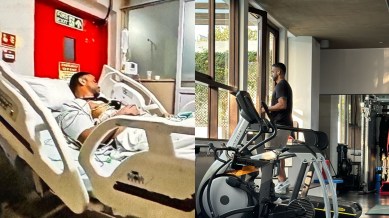📣 For more lifestyle news, click here to join our WhatsApp Channel and also follow us on Instagram
Zerodha CEO Nithin Kamath suffers ‘mild stroke’: Understanding causes, recovery and prevention tips
As Nithin Kamath opens up about experiencing a stroke, let's gain a deeper understanding of the health issue from experts with tips on prevention

Nithin Kamath, co-founder and CEO of Zerodha, revealed on Monday that he had experienced a ‘mild stroke‘ six weeks ago. He attributed this stroke to a combination of factors, including the recent passing of his father, poor sleep, exhaustion, dehydration, and excessive working out.
To gain a deeper understanding of this health issue, we consulted experts.
What is a stroke?
According to Dr Jyoti Bala Sharma, director of neurology at Fortis Hospital, Noida, a stroke occurs when the blood supply to the brain is disrupted. “Brain cells or neurons do not receive oxygen and nutrients, leading to their death. Approximately 1.9 million neurons die every minute. As time progresses, a larger area of the brain is affected. Since all bodily functions are controlled by the brain, the functions controlled by the damaged brain are lost,” she told indianexpress.com.
This can lead to various neurological deficits, said Dr PN Renjen, senior consultant, neurology, at Indraprastha Apollo Hospitals, New Delhi. “Paralysis, difficulty speaking, or cognitive impairment can occur. Early intervention is crucial to minimise brain damage and improve outcomes for stroke patients.”
What are its causes?
Dr. Renjen explained that causes can be broadly categorized into two main types — ischemic and hemorrhagic. “An ischemic stroke may arise from thrombosis, wherein a blood clot forms within a brain vessel, leading to obstructed or narrowed blood flow to the brain. On the other hand, a hemorrhagic stroke is caused by the rupture of a blood vessel within the brain, resulting in bleeding into the surrounding tissue. Such hemorrhages can occur due to various factors, including aneurysms or arteriovenous malformations.”
However, Dr Sharma noted that the majority of strokes (85%) are due to artery blockage by a clot, while only 15% are caused by blood leakage into the brain.
Since stroke is a preventable condition, Dr Sharma emphasised that four out of five strokes can be prevented by controlling risk factors. “Lifestyle changes, such as physical inactivity, unhealthy eating habits, and stress, are the primary reasons behind strokes. This leads to a rising incidence of obesity, diabetes, and hypertension at an early age, which are major risk factors for stroke. Additionally, smoking and excessive alcohol consumption add to the risk. Other significant risk factors include pollution, obstructive sleep apnea, and high cholesterol,” she added.
So, what are the effective measures to reduce the risk of stroke?
- Eat a healthy diet: Consume a diet high in fibre, low in carbohydrates, and high in protein. Opt for whole grains and millets with a low glycemic index, which release energy slowly into the bloodstream, keeping you mentally alert throughout the day. Include sources of fibre such as oats, flax seeds, chia seeds, or basil seeds. Choose fruits over junk food as snacks and keep them handy in your bag.
- Exercise regularly: Engage in physical activity for at least 45 minutes, five days a week.
- Quit tobacco consumption: Avoid smoking, vaping, or chewing tobacco, as well as exposure to secondhand smoke.
- Consume alcohol in moderation: Men should not exceed three pegs a day, while women should limit themselves to two pegs.
- Maintain a healthy weight, waist-hip ratio, and BMI: The normal waist-hip ratio is 0.95 for men and 0.80 for women. The healthy range for BMI is 18.5 to 24.9.
- Monitor your blood sugar, lipid levels, and blood pressure regularly.
- Manage stress: Practice yoga, meditation, and pursue hobbies to reduce stress. Cultivate habits of gratitude and stay socially connected.
📣 For more lifestyle news, click here to join our WhatsApp Channel and also follow us on Instagram